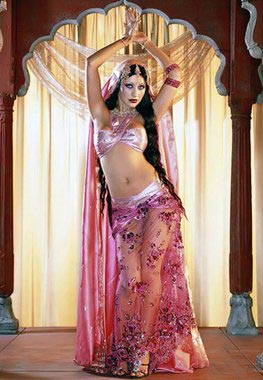| Home / Living in China / What's New | Tools: Save | Print | E-mail | Most Read |
| Dance Like a Bollywood Diva |
| Adjust font size: |
Think of However, Bollywood dance is usually confined to DVDs and the glamor of the Indian movie industry, centered in Mumbai, formerly Now, however, expats and locals in Sangeetha Sander, an Indian-German dancer and newcomer to the city, has started a Bollywood dance class this month at Jazz du Funk and promises that anyone who makes an effort will be able to master it.
"It has no proper rules and definitions of how it should be danced. It is more about the way of expressing what songs are about," says Sander, who moved to "Many people here seem to be very interested in Most of Indian movies can be compared to a kind of musical. There are usually five to six musical numbers in a movie, occurring in places where the hero or heroine is are happy, sad, in love, and so on, says Sander. "These are the songs that we use for Bollywood dance. They can be very modern, folkloric, traditional or classical and are as important a part in movies being well-received as the story of the movie itself," she says. "Actually, 'Bollywood' to describe a type of dance is a fairly new concept. Originally the term referred to a regional film industry but was exploited in the non-Indian world to describe the whole of Indian movies and its music," says Sander, who tries to show people the differences by presenting them a variety of such songs and dances from all over India. Although she grew up in "I grew up speaking my mother tongue Tamil (a South Indian language) and German simultaneously. My mum taught me how to read and write my native language and from my early age on, I knew that Learning Indian dance early, she began to study classical Indian Bharathanatyam at the age of seven. Later, she studied regularly with master Sudarsanakumar from the famous Kalakshetra School of Dance ( "With him, I learned more about this graceful and simultaneously energetic art of dance, which through its facial expression, hand gestures and body movements tells mythological stories that are well-known in In 2003, Sander and two other dancers formed the group Triveni. "We wanted to stay true to our roots and find different ways of transporting our Indian culture through dance. Having the rich and strong basis of classical Indian Bharathanatyam as our background, we found Indian film music to be the most appropriate means for this," she says. Unlike classical Indian music that was harder to digest, the lightness of film music was helpful to get a non-Indian audience more easily acquainted with parts of an Indian culture. "We began to choreograph pieces and our first presentations were received with much enthusiasm and acclaim. The audience was much more able to relate to the themes of the songs. They are not mythological but speak of real life situations." In Sanders makes her students feel special, feminine and unique, says Rashmi A. Urhekar who has taken two of the classes. "Basically I am an Indian, and also a Bharathanatyam dancer, so for me it's very good opportunity. Normally foreigners find Indian dancing style quite difficult as it has lot of facial expressions and unusual postures, but she makes it very easy to understand and explains the meaning of songs for better understanding," says Urhekar. A Chinese student, Guo Jingjing, says she likes Bollywood dance very much. "It's fun and joyful, and shows people's optimistic attitude toward life," says Guo, adding that Sangeetha is a teacher with strong personality, "combining traditional moves with modern elements, which helps us better know Indian culture. "I hope the course can be divided into beginner's level and intermediate level, which might enable us to learn more systematically." Sander herself says the dance isn't difficult to learn. She says its influence of different kinds of dances allows everyone to do it as long as they are willing to go with the music. And there's not too much technique. What is challenging about Bollywood is the ability to use the face to express feelings, which is different from hip-hop, jazz, ballet, belly dance and other forms. "Bollywood exaggerates because it wants the audience to understand whether it is a happy, sad or a love song. For example, they are describing the beautiful bride in a wedding ceremony or the shy way the heroine expresses her love for the hero. "This is sometimes not so easy because students might not know how an Indian bride looks, how important an Indian wedding is, or why the expression of love in Indian movies is so different from just saying 'I love you'." With some tips for those just starting out, Sander recommends that dancers go barefoot and wear comfortable dresses for training. "For a performance it looks very beautiful when you wear Indian traditional dresses like a gagra, sari or salwar and appropriate jewelry. The right kind of makeup gives the dancer a special touch." But most of all, she concludes, "be open to a different kind of music, don't feel shy about using your face and body for expression and go with the flow." Bollywood Dance Venue: Jazz du Funk, Bldg C, Tel: 021-52399922 Website: www.jazzdufunk.com Fee: 100 yuan for casual drop-in class; 850 yuan for any 10 lessons in one month (please inquire for rates) By Jenny Hammond (Shanghai Daily July 20, 2007) |
| Tools: Save | Print | E-mail | Most Read |
 |
| Related Stories |
|
